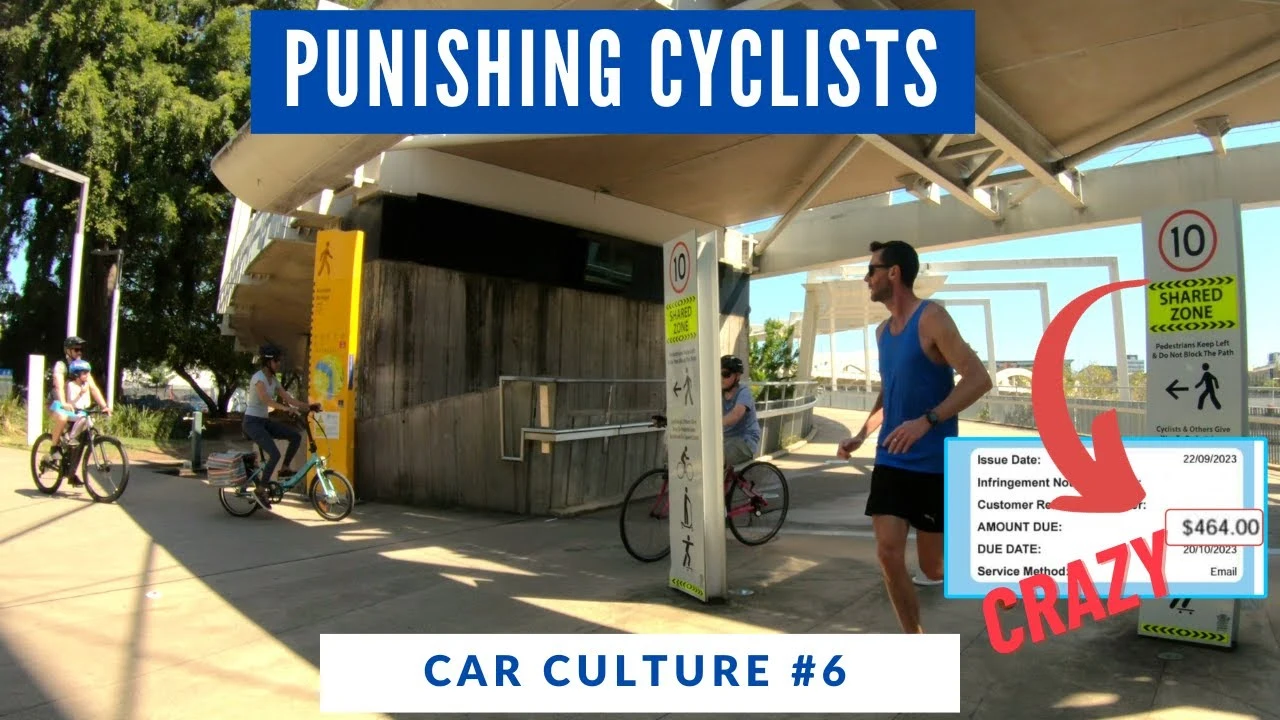Pinging @ApeNo1@lemm.ee, who left a lengthy critique of the video which, while ultimately wrong, was at least more reasonable than some of the dumb takes that have been left up in this thread by other users.
The issue with motornormativity is the notion that penalising people who choose modes of transport other than car in precisely the same way as cars are penalised without regard for the actual level of risk involved is insane. Hundreds of people die in this country every year as a result of cars. Guess how many die because of cyclists? Going 10 km/h over the speed limit in a car is a much, much greater danger to the public than going 10 km/h over the speed limit on a bike.
This is even greater when the speed limit itself is poorly thought-out. We allow cars to drive past schools full of 6 year-olds at 4 times the speed we allow cyclists to ride the Kurilpa Bridge. When the Minister for Transport himself, escorting a foreign dignitary, shares himself going an average of 6 km/h over the speed limit on the bridge, it’s a pretty solid indication that the speed limit here is inappropriate. As the video itself said, the normal minimum speed you’d expect a bike to be doing on a shared path is about 16 km/h, and going under 11 km/h is—according to the government’s own recommendations—unstable and risky.
Something the video didn’t quite go in to as explicitly, but hinted at in a way that was very clear for those already aware, is how the speed limit changes are indicative of the hefty car-brain of our current government. This speed limit was changed at some point after November 2021, without any consultation or public information. That never happens with roads. Even a modest change reducing a speed limit on a residential street from 50 to 40 undergoes heavy review and is unlikely to happen if even a small vocal minority opposes it. That’s motornormativity in action.
What’s more, this speed limit change (and frankly, even the old speed limit itself) was made completely without evidence. There have been no pedestrian injuries on this bridge in the last 20 years. Usually, we try to make policy based on evidence. Or if we don’t, that’s certainly what we should be aspiring to. The evidence here tells us: this is not necessary. If there’s an area where cyclists are frequently endangering pedestrians, first of all: we already have rules in place to enforce that, without going to unreasonable speed limits. But second, maybe, if there were evidence suggesting it would actually help, we could consider putting a speed limit in place in that location. The simple fact is: cyclists aren’t expected to have speedometers, so trying to enforce speed limits against them is ridiculous.
And, if you were going to enforce it, the fine should not be the same as it is for drivers. Because the amount of damage they’re likely to cause is orders of magnitude less.
I took down my comment as I kept on reading more articles after I posted it and saw there was more to it than just this video and individuals comments and felt my comment was pretty misinformed. Glad you took the time to respond as again I had never seen the term motonormativity before and was keen to learn more.
Yeah for sure, it’s a term that’s fairly new to me too. I probably first heard it earlier this year. I actually thought your comment was a really respectful one, even if I disagreed with it.
Another term you might come across is “car-brain”. This term is basically synonymous with motornormativity, though perhaps somewhat more focusing on how motornormativity infects individuals, and less so on its systemic problems.
I found on many government sites that a fairly common consensus was that safe bike speeds for areas shared with pedestrians should be around 12km/h to 25km/h, one even said 15 to 25, so being fined $400+ for doing 22km/h was unnecessary. I still believe having speed limits defined for these types of areas is important to ensure public safety, but agree 10km/h, which is essentially just a jogging pace, is unreasonable, with a more appropriate fine being say sub $100 for people doing 30km/h+ in a shared zone.
The complication I also saw is that few people would have a speedometer on their bike so it would need some common sense and judgement. People could use their phones for this but it would make more sense that they are looking at their surroundings and what is up ahead rather than looking down at a phone screen.
which is essentially just a jogging pace
It’s slower than a slow jog.
The complication I also saw is that few people would have a speedometer on their bike so it would need some common sense and judgement
This exactly. But you don’t need speed limits to do that. Just enforce the usual reckless driving/riding laws.
Police like speed limits because they’re lazy as fuck and can just set up a trap without having to do any real work. They like it against cyclists especially because they’re arseholes who hate cyclists. (As evidence for this, I submit the fact that they regularly do “bell blitzes” despite the fact that bells are a completely useless implement when you have a voice, as well as how they enforce these ridiculous speed limits. And the fact that they refuse to ever prosecute dangerous driving by drivers when reported by cyclists with video evidence.)
I think saying it is slower than a slow jog underplays it a bit. 10km/h is a 6 min km which is a common running speed for amateur runners and a reasonable speed, 12km/h is a 5 min km which requires above average fitness, and 15km/h is a 4 min km which is an elite amateur pace. Anything approaching 20km/h is elite professional athlete level.
I think the point is still the same though. You have now introduced another new term to me. “Bell Blitz”. Really going after those worst of crimes.
I’m a runner and personally, my slow easy runs might go as slow as 5:30s, at the extreme end, which is why I said that 10 km/h is slower than a slow jog. 5:00s is more my usual slow run pace for runs less than 12 km in distance. But yeah, I guess it’s mainly a semantic point. The important thing is that when running, one can easily exceed the supposed speed limit on that bridge, which is just crazy.
The bell blitzes strike me as the same kind of stupid as when they crack down on “jaywalking” by pedestrians in the CBD. In a better world, our entire CBD would be a shared-use zone where cars can drive if they need to, but pedestrians always have right of way. Likewise, the bell law should just be done away with. But our politicians are so car-brained the idea of these is abhorrent to them.
In a better world, our entire CBD would be a shared-use zone where cars can drive if they need to, but pedestrians always have right of way
Pedestrians do have right of way, at least in QLD. There’s no situation where it’s acceptable to run over a pedestrian except if it was literally impossible to avoid doing so (e.g. if a pedestrian sprints across the street unexpectedly and the driver has no time to swerve or hit the brakes).
That doesn’t mean it’s legal for pedestrians to obstruct traffic. J-walking leads to traffic jams which leads to situations where pedestrians/cyclists/etc are more likely to be run over and killed. When someone j-walks on a busy streat they are placing lives of other pedestrians in danger.
Even a modest change reducing a speed limit on a residential street from 50 to 40 undergoes heavy review and is unlikely to happen if even a small vocal minority opposes it.
That doesn’t happen in my city.
For example there are two intersections on my commute that are virtually identical (they’re on the same stretch of highway and they are exits for neighbouring beach suburbs with the same intersection design). One of them is 100km/h for through traffic and the other is 40km/h. Why? No idea. But if there was “heavy review” then surely they would have the same speed limit. It’s been like that for something like ten years, locals just ignore the speed limit on the slower one and if there’s a cop car behind you they’ll be annoyed if you slow down. Police setup speed traps near that intersection all the time (almost every day), but I’ve never heard of them doing it on the intersection. They enforce the 100km/h limit, not the 40km/h limit.
Going back on topic - this is a bridge built specifically for cyclists. The speed limit is absolutely intended to be obeyed by cyclists and has nothing to do with cars. And if you can’t ride 10km/h safely then you shouldn’t be riding at all.
That doesn’t happen in my city.
I won’t speak for what goes on in your city, but it is definitely the case in Brisbane. And honestly, I’d be surprised if the one specific example you’re pointing to isn’t an oddity for some particular reason, and the general trend is the same.
We literally had the Lord Mayor call it “socialist” to suggest that 30 km/h speed limits on local residential streets is best practice. That same Lord Mayor’s government voted down a petition that was apparently signed by every single resident on the street to reduce their speed limit because it was being used for ratrunning by trucks doing construction nearby.
I’m in regional QLD, and this is no where near the biggest problem we have.
For example a major highway (National Route 1, which passes through every major city in Australia) goes through a a mountain range just 20 minutes from the CBD and closes almost once a week for an average of 6.6 hours due to car crashes which are difficult to recover. The detour when the road is closed adds 3 hours to the drive time and worse it’s unsafe (and illegal) to perform a U turn anywhere on the entire stretch of road up the mountain so whenever it closes thousands of people get stuck and just have to wait until the road opens (which again, takes hours). Emergency services are forced to drive on the wrong side of the road around hundreds of narrow blind corners to reach the accident, and anyone who does turn around is risks crashing into them.
A multimillion dollar review into wether something should be done about it was delayed repeatedly for years and then finally carried out during a full covid lockdown when we had the highest number of covid cases the city saw in the entire pandemic and businesses were only allowed to open if they were declared an essential service. Nobody could leave their home except to go to those essential services and even then you weren’t allowed to travel to other cities or towns except for very rare excuses. Traffic on roads between cities/towns, like the range being assessed, was obviously almost zero and surprise! They determined that traffic was minimal, nothing needed to be done, they didn’t observe any crashes during the short review period, and recommended re-assessing the situation in 30 years time. When the population of the city is expected to be more than double what it is right now. Great.
The silly speed limits on my commute are, frankly, way down on the priority list compared to issues like the one I just detailed. I could list more serious problems that are being ignored. And these issues are state or national highways, so the local council doesn’t have the juristiction (or budget) to deal with them.
That doesn’t sound good, but it’s like…completely unrelated to this thread. Not sure why you brought it up.
i dont fully agree with the points made, but i do think there are edge cases where rules that apply to cars dont make sense for cyclists, probably the main one that comes to mind is Stop signs and coming to a complete stop. I dont think that is a rule that makes sense for bikes (and can be less safe in some cases) but where rules apply, i dont see why fines should be any different
i dont see why fines should be any different
Very simple. A driver going 10 km/h over the speed limit has a far higher chance of causing far more damage than a cyclist does.
sure, but then we have to do everything by weight class (like that chart i think it was you that posted?) be the same for motorbikes, trucks etc.
Also need to consider its not just about the potential direct damage that can be caused, a cyclist breaking certain rules could endanger other drivers indirectly such as blowing through a stop sign causing breaking which could lead to an accident caused by a vehicle etc. I say all these things as a cyclist by the way (username checks out?)
edit: by the way the situation mentioned on that bridge is definitly a strange one and really needs some sort of change there
but then we have to do everything by weight class (like that chart i think it was you that posted?)
Not me. Someone else posted that.
But I mean, would that be the worst thing? We already do rego based on weight class, up from bikes which don’t require rego to heavy trucks which pay the most.
But anyway, no, we wouldn’t have to do it that way. Up until the Newman Government instituted the changes, we had a fairly sensible policy (something that could, frankly, be said about a lot of Newman’s policies). Most of the world still has sensible laws in this regard.
such as blowing through a stop sign
fyi literally any expert will tell you that stop signs being treated as give way signs is far better for safety than actually trying to enforce stop sign laws for cyclists. It’s called the “Idaho stop”.
Anyway, all this “could” is all well and good, but our policies should be based in evidence. There’s no evidence to suggest that it’s either necessary or helpful.
We already do rego based on weight class
fair point, cant fault that argument actually
I agree on the stop sign comment by the way, I touched on that in my initial comment although in this one ‘blew through’ i implied a little more than an Idaho stop :) just first thing that came to mind but im sure there are other examples, or take a red light or something.
He hasn’t really convinced me that cyclists shouldn’t be fined for breaking the law the same as drivers. He has however convinced me that the speed limit on that bridge is laughably too low.
He hasn’t really convinced me that cyclists shouldn’t be fined for breaking the law the same as drivers
Yeah the video didn’t really focus as much on that point as it probably should have to earn its title. It made a few points in that regard, but the focus was more on that specific speed limit.
But I would ask, very simply: why should the punishment be the same? That’s really the most relevant way of framing it, because that’s the positive claim being made, and you can’t really prove a negative other than to suggest that there’s no evidence in favour of the positive. (I can’t prove “there’s no yeti”, but I can say “well there’s no evidence on which to justify believing in a yeti.”) It shouldn’t be on cycling advocates to justify why the punishment should be less, but on the car-brained to explain why they should be the same.
So why should the punishment be the same? The risk is drastically less, as evidenced by the crash rates and crash severity. So what is it?
But I would ask, very simply: why should the punishment be the same?
For the same reason we don’t fine drivers $10 for driving like idiots. If cyclists can ride around town with no regard for safety and the law, because the worst they’ll face is a $10 fine, then why should they be safe riders?
That’s the car brain talking. It’s not a cogent explanation.
Why, when cyclists factually do not cause anywhere near the same level of harm as drivers, should the fine be the same?
It’s nothing to do with that. It’s about lack of consequences. A $10 fine is no deterrent at all for obeying the law. For any road user.
It’s well-known that severity of punishment has very little bearing on deterrent effectiveness. What works is likelihood of facing that punishment at all.
But again, enforcing speed limits on bikes just makes no sense. It’s responding to a risk that basically doesn’t exist, and any resources that could be spent on it would be far better spent ensuring drivers don’t break the law.
Of course, that would require cops doing the right thing in the interest of actual safety. But the truth is, cops don’t give a fuck about that. They’re as car-brained as our politicians, if not more so. They’ll spend heaps of resources enforcing these nonsense speed limits, while they refuse to enforce laws like the minimum passing distance for cyclists even when they’re literally handed the evidence needed.
while they refuse to enforce laws like the minimum passing distance for cyclists even when they’re literally handed the evidence needed.
It’s not enough to show video footage of a car passing a cyclist. The cops need to know who was driving the car.
Police speed/red light/mobile phone/etc infringement notices are only issued if they have an accurate photo of the driver’s face (or, if they pull over the vehicle immediately and identify the driver). To achieve that they use powerful flashes when the photo is taken. They send the notice to the registered owner of the vehicle but they also need the photo to sort things out when the driver says “that wasn’t me”.
A bicycle GoPro is just too small, and has no flash. You’d never be able to identify the driver.
- Police have the power to require the owner of the car nominate who was driving at a given time. They just refuse to use it.
- They refuse to prosecute even when evidence of the driver is available (for example, when you catch up to them later and clearly show their face).
Because riding around unsafely is a good way to end up in the back of an ambulance.
It’s not about the $, it’s about the survivability of an accident.
Sitting here, that sounds like a reasonable argument. Yet experience shows us that people are idiots. They go around with the mentality of ‘It will never happen to me.’
Have a look at this on the ABC today. Specifically the bit about the lack of road rules in the late 60’s:
In the 1960s, seatbelts weren’t mandatory, speed cameras hadn’t yet been introduced and drink driving went virtually unchecked. It was a time of carnage on our roads.
In 1970, the worst road toll year on record, 3,798 people lost their lives.
That’s more than three times higher than the figure for last year, when 1,194 people died.There you are - evidence that laws about road safety save lives. That’s no statistical outlier. Road deaths plummeted after the introduction of safety laws. Yes, they have reduced even further in the past 20 years with the introduction of better vehicle safety features, but that doesn’t come close to explaining all of it.
I know we’re not literally talking about removing the laws for cyclists. Yet, my argument remains: If the fines for cyclists are negligible, they will be disregarded. They may as well be removed.
The risk is drastically less, as evidenced by the crash rates and crash severity.
Is it? Vic Roads claims you are up to 10x more likely to be killed if you travel by bicycle vs car. And it would make sense to me that you’re more likely to be killed if you ride fast. Certainly all of my own bicycle crashes have involved speed - I’ve never suffered any injury at all, not even a bruise, when I was riding at a leisurely pace.
Your claim that there’s no risk to cyclists is clearly wrong. Injuries when a cyclist hits another cyclist or pedestrian are severe.
It would, obviously, be ideal to separate pedestrians and cyclists so they don’t share the same bridge. Or make the bridge wide enough to have separate lanes… But in the real world that’s those just won’t happen and it still doesn’t help with crashes between two cyclists - which are a lot more likely to happen when you have a mix of fast and slow cyclists on a narrow bridge.
But anyway, I generally reject your assertion that the punishment should be matched to the level of risk. For me the punishment should be set at whatever level is necessary to encourage the majority of riders to ride safely. And it’s not up to the police to determine what speed is “safe”. That determination is up to the town planning contractors who set the speed limit on the bridge.
If it was a slap on the wrist fine, everyone would ignore the speed limit. That doesn’t seem right to me at all.
None of the bridges on my commute have speed limits. When I cross them I generally do drop down 1st gear and ride at less than 10km/h (and my bicycle does have a speedometer, so I know I’m going less than 10). If there are pedestrians I slow down to walking speed or even stop while they walk past. Why risk hurting someone? I’m not in a hurry.
Vic Roads claims you are up to 10x more likely to be killed if you travel by bicycle vs car
Yes, that’s caused by the cars. It’s a different conversation.
We’re talking about the risk to pedestrians caused by cars versus cyclists.
Please do not post comments that do not engage with the arguments raised in the video. Not just it’s clickbait-y title. Further low-effort responses will be removed
I don’t necessarily think the title was click-baity, to be honest. It’s a pretty honest assessment of the content of the video.
It’s a bit inflammatory perhaps, but only because the facts are so far out of step with the beliefs of the car-brained way most Australians have been brought up to think.
That aside, thanks for trying to keep the tone here better. Some of the low-effort comments here were quite disappointing to read.
The annoying thing is the Lemmy API has been changed to not return the child comments of a removed comment. It’s really annoying because sometimes (like this) I get in too late and there’s a comment that should be removed but there’s a good discussion following it (rarely with the original commenter). I’ll create an issue at some point unless they’ve already fixed it
It always amuses me when people downvote moderator warnings. I’ll take it to mean that you don’t want civil and respectful discussions to occur and just want to engage in some flame war. If you would like to see some changes, feel free to let me know
Seems to be a case of low speed limits are good for other people but not him, which I do find a little amusing. Overly low speed limits are a bugbear of mine so I do sympathise with the feeling but since he’s a ‘huge advocate’ for 30km/h zones in a car it’s pretty ironic. After all the same reasons for 30km/h zones (e.g. people might be on the road and slower moving vehicles means less risk of injury) do also apply to riding a bike over a busy bridge where there’s basically guaranteed to be people in the way. I do like the mention of bicycles being designed to travel at higher speeds considering that’s a common sentiment for those of us in cars and motorbikes as well.
I kind of like the idea of reducing fines based on mass though, us motorbike riders would support that…
Seems to be a case of low speed limits are good for other people but not him
Umm, did we watch the same video? He literally spends a significant amount of time pointing out that the government’s own guidelines explain why the speed limits are inappropriate. Their data says going under 11 km/h can be unstable, and that the comfortable minimum speed should be 16 km/h. And their own guidelines say that enforcement of speed limits is not a viable option.
What I found amusing was the bringing up of these ideas:
- Breaking the speed limit is different to exceeding a safe speed for the conditions.
- My self assessment of a particular area and my skill limit indicates there should be a higher speed limit.
- My vehicle is designed to operate safely at higher speeds than the limit.
- My vehicle is designed in a way that makes sticking to the lowest speed limits awkward.
- Police are fining people huge amounts of money for exceeding a speed limit myself and many others think is too low.
These are all very familiar to me as a driver and motorbike rider so that’s where the irony comes in - despite being a proponent of low speed limits he’s complaining about a low speed limit using similar arguments as everyone else now it affects him.
For what it’s worth I agree with him that the speed limit there is too low (as it is on many roads), but I think the better response should be to raise it to something sensible (for what is apparently a busy shared path 20km/h seems a more reasonable limit) rather than either removing the limits or saying you can’t fine riders for exceeding them.
The first two and last bullet points might apply to motor vehicles, but the third and fourth certainly do not. Anyone claiming that it’s not safe to operate a car at 30 km/h is just lying. There’s just no way to make that argument without deliberately saying something that you yourself know to be completely untrue.
for what is apparently a busy shared path 20km/h seems a more reasonable limit) rather than either removing the limits or saying you can’t fine riders for exceeding them
The thing is, the Goodwill Bridge, at the other end of Southbank, is 20 km/h. But it’s very notable that this is still inappropriate there. While 20 km/h is a reasonable speed for someone on an upright dutch-style bike riding on the flat, the Goodwill Bridge has rather steep inclines—and, more pertinently, declines. Staying under 20 km/h on a road bike on a fairly steep downhill is not much less ridiculous than the 10 km/h limit of the Kurilpa Bridge.
But then it comes back to the simple matter of logistics. Cyclists aren’t required to have speedometers, and while some sports cyclists have them anyway, they usually rely on GPS which is much less accurate, especially around the inner city, than the direct-drive speedometers of a car. It doesn’t make any sense to enforce a rule where it’s impossible for the culprit to know they are in violation.
The fact that this conversation is even taking place is a sign of some pretty severe car-brain on the part of people who support the speed limits. Speed limits aren’t in place for cars arbitrarily. They were created because cars are really, really dangerous. Cars kill hundreds of people per year in this country alone. Speed limits make sense, because they’re one of many tools to help keep that number from getting even higher. No evidence exists to support the need for speed limits on bikes. The only argument that is ever made essentially boils down to “cars have them, so bikes should too.”
The first two and last bullet points might apply to motor vehicles, but the third and fourth certainly do not
They certainly do. It’s a fact that most cars and motorbikes are designed to be able to travel safely at speeds greater than our highway limits, and it can indeed be awkward to do low speed limits in a motor vehicle. For example my VTR runs faster than 20km/h at idle in first gear, which makes travelling in 20km/h zones annoying because I have to be on the clutch constantly. I could also claim that it’s unsafe to go that slow on a motorcycle due to instability, but really that’s just as true as saying 10km/h is too slow for stability on a bicycle - there is an element of truth in it but we both know it’s perfectly doable for anyone who’s been riding for a while.
I could also claim that it’s unsafe to go that slow on a motorcycle due to instability, but really that’s just as true as saying 10km/h is too slow for stability on a bicycle - there is an element of truth in it but we both know it’s perfectly doable for anyone who’s been riding for a while.
To get a motorcycle license in QLD you are required to demonstrate your ability to ride safely at 5km/h. It’s not easy, you often need to apply the brakes and clutch and throttle all at the same time and oh yeah counter-steering? It doesn’t work at 5km/h. But, every motorcycle rider with a license can do it. And trust me it’s a lot easier on a bicycle.
I’d argue if you can’t safely ride slow on a bicycle then maybe you should get off the bike and walk across the bridge. Being able to ride slowly is an essential skill especially when you’re sharing the path with pedestrians, which as we all know happens all the time.
deleted by creator
Removed by mod
Did you watch the video?
deleted by creator
We don’t want the same rights. We don’t want to be allowed on highways. Cyclists take up much less space when parking, too, so parking in an incorrect spot is not such an issue.
Also I don’t mind paying $10 in road tax if motorists pay their fair share too:

Whenever there’s any sort of bike vs car debate, the “don’t pay road tax” argument always comes up. It’s such a strange argument. While I’m sure they exist, I don’t know any cyclists who don’t also have a car / driver’s license.
When I commute to work on the bike, there’s a car sitting in the garage that I’m paying road taxes for that is not creating more traffic/pollution. It is not taking up a parking space in the city.
I’m also lucky enough to live in a city where I have a dedicated bike lane for all but the first and last few hundred meters of my commute. So I don’t buy the ‘traffic jams’ argument either. I’m actually faster than cars in the CBD, they slow me down.
Wild that chart doesn’t include a motorbike of some sort honestly.
Same deal as fat man really, my 300cc was like 150kg
deleted by creator
We wouldn’t have to if we had bike paths -_-
You know that most of the urban population can get by without using cars on 95% of their days even in Australia’s limited public transport infrastructure, and there’s something you need to face:
Eventually, you’ll have to. Cars are unsustainable.
So the sooner bike-friendly infrastructure that allows cyclists to get around without illegal shit or inconveniencing others hets built, the better. They’ll get safer journeys and motorists will feel the drop in traffic even if your roads get narrower. Cars are those that need extra red tape – I would suggest taxes based on car weight for the urban population (farmers in the outback is somewhat justified for owning trucks).
TL;DR: The cunts here are people driving increasingly big cars.
Australia’s limited public transport infrastructure
I’m sorry, are we living in the same country? Like, Australia’s PT isn’t great by any means. Interstate rail services are completely dismal. But I think it’s a bit of a stretch to call it limited? The capital cities have fairly decent train services, as well as extensive bus lines. Fares are also heavily subsidised by the government here compared to elsewhere in the world. You can get anywhere in Victoria now for less than $10.
On top of that, there are major PT infrastructure works going on in most cities. Melbourne has the Metro Tunnel, Sydney has the City & Southwest Metro, Brisbane is building Cross River Rail.
Like, bike’s can absolutely be an important part of a multi-modal journey. But to imply that they’ll be the only option because of “limited” public transport is dishonest at best.
are we living in the same country?
No, I’m Czech, as per the username. My Sydney aunt came to Prague last month and says that it’s night and day.
Where we would run tram routes, you have buses that don’t even have next station displays/announcements so taking a journey requires considerably more knowledge and planning.
She is happy about the bike paths, though.
Easy enough to calculate yourself. A quick Google says that an average motorbike might be as much as 700 pounds, and if we use the same “fat man” as the bike (300 lb), that’s a total of 1000 lb. The formula for comparative damage is (W1/W2)4, so plug that in and we get (1000/350)4, or motorbikes doing 66× the damage of the bike, or 0.00396.
If a cyclist had to pay a $10 fee, as @ChaoticNeutralCzech@feddit.de suggests, motorbikes would pay $660, while the average car driver pays a whopping $1,100,000, if you were trying to accurately account for damage done.
Firstly, you’re an Aussie, I’m an Aussie and we’re on an Aussie instance, the heck are you using pounds for? Secondly, there’s not a chance in hell the average motorbike weighs 317 kilograms! A Honda Goldwing, notoriously one of the chonkiest, plushest experiences in motorcycling, is only 390kg, and they have an 1800cc flat-six engine. I used to ride a 500cc twin and at 192kg it was heavier than a lot of 1000cc 4cyl that have more expensive, lighter materials. These days, I have a Postie Bike and that’s exactly 100kg lighter than my 500 was. It’s the equivalent of carrying a slightly overweight dude on my shoulders.
I only used pounds because the table the user above shared was in pounds. And comparative damage is just that: comparative. It’s the fourth power of the ratio between the two. So keeping to the same units was easiest.
Regarding the rest of it, remember we’re comparing it to a “freakishly heavy bicycle”. The table the other user shared implies a fat man + bike is 350 lb. My assumption was that’s 300 lb person + 50 lb bike. That would be a 23 kg bike. That’s crazy heavy. It’s more than double most bikes’ weight, and triple the weight of a racing bike. So if the motorbike weight I used is an overestimate, that’s basically just evening the playing field. (While both will still end up looking worse compared to a car than they should—which just highlights how much better both are than cars.)
Anyway, I got the figure by just Googling “motorbike weight”, which turned up this page, which says:
Some sources say the “average” motorcycle weighs around 700 pounds, but the weight depends on the brand of the bike, the engine size, and the style—whether it’s a street, off-road, touring, cruiser, or sport bike, or something else entirely.
I’m not interested in being precise enough to delve into those different factors, so going with the quoted “average” sounded good to me.
That would be a 23 kg bike. That’s crazy heavy. It’s more than double most bikes’ weight, and triple the weight of a racing bike.
It’s actually not that crazy. E-bikes tend to be at least that heavy. Mine is 30kg. In our example of a fat man riding a bicycle, he’s probably more likely to be riding an electric bike anyway.
Lol my ebike is 35 kg, and I’m American weighing in at 155 kg, so about 200kg fully loaded on my bike. But I live in an area with pretty fantastic bike trails that have speed limits near 25-30kph.
There’s not a snowflakes chance in hell the average is anywhere near that high in Australia, or most of the world. I’d put money on it being a US-only figure, considering their obsession with large cruisers. If you include motorised scooters, which I was, then I’d say the average would be about 200kg. Considering the rate increases exponentially, I think that’s important.
deleted by creator
You sound like someone who drives an American “truck”.
Cyclists are freeing up the roads from extra traffic by them not adding another car onto the road. They benefit us far more than they will ever hinder us.
What a dumb take.
Removed by mod
He’s saying cyclists shouldn’t be punished the same as cars are for a much less severe crime, yes.
It’s a dumb take and shows a severe lack of critical thought, “cunt”.











